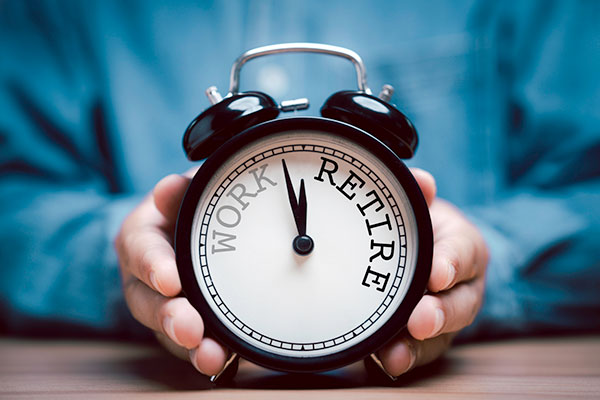Is it time for a midlife retirement MOT?
Middle age is a great time to give your pension savings a thorough service, and identify the action required to retire on your own terms, writes Rachel Lacey.
4th September 2024 13:09
by Rachel Lacey from interactive investor

How’s your retirement planning coming along? If your (honest) answer is somewhere within the realms of “I really have no idea” you won’t be alone.
Once you’ve set up your pension and your monthly contributions are going in, it’s easy to forget about it, with research from the Financial Conduct Authority (FCA) showing that far too many of us do not engage with our retirement saving, or know where we stand.
- Invest with ii: What is a SIPP? | ISA vs SIPP | Open a SIPP
Women, in particular, were more likely to be in the dark - with 57% admitting that they hadn’t reviewed their pension in the last year, compared to 46% of men. It was a similar story with charges, with 60% of women and 44% of men having no clue how much they are paying to save for their retirement.
But whatever your gender, if you’ve entered the realms of middle age and haven’t looked at your retirement planning in a while, it’s a good idea to give your pension plans a midlife MOT.
Not only is this a great way of flagging problems while you still have the time to fix them, it can also help you find ways to boost your pension and give your future self a pay rise.
From checking in on your state pension to reviewing your private pensions, here are some ideas to get you started.
1) Check your state pension age
Irrespective of your own retirement plans, your state pension will play a core part of your later-life finances, so it’s crucial you know when you can start claiming yours. The state pension age is currently 66 for both men and women but is scheduled to start increasing again from 2026. To avoid any unwelcome surprises in your 60s, you can find out when you will reach state pension age here.
2) Get a state pension forecast
The full state pension is currently £221.20 a week (2024-25) but the amount you get will depend on a range of factors including your national insurance contributions (NIC), whether you contracted out of the state pension or paid into the additional state pension before 2016 (when the new state pension was introduced).
- Sign up to our free newsletter for share, fund and trust ideas, and the latest news and analysis
- How to strike the balance between saving and spending in midlife
It’s a complicated system and not easy to work out yourself, but you can find out your position by getting a state pension forecast. This will give you an indication of how much you can expect, when you will get it and – in the event of any unpleasant surprises – the steps you can take to increase it.
This could include buying voluntary NICs if your record is falling short of the 35 years required for the full state pension.
3) Gather your private pension paperwork
Next you need to turn to your private pensions and gather together the paperwork for all your schemes – not just the one you’re currently paying into. Try linking up a pension for every job you’ve had. You might not have one for older positions, but you should have been automatically signed up to a workplace pension for all your jobs in recent years (so long as you met the earnings’ criteria and didn’t opt out) following the roll-out of auto enrolment between 2012 and 2018.
If you’ve lost track of a pension – easily done if you don’t update all your providers every time you move house – you might need to do a bit of digging. You can start by contacting your former employer or ex-colleagues who might be able to remind you of the company running the scheme. If that doesn’t work, you can use the government’s pension tracing service or try Gretel, a free online service for tracking down lost pensions, savings and investment accounts.
It might involve a bit of legwork but don’t let that put you off – according to The Pensions Policy Institute, there are over 2.8 million lost pensions worth a staggering £26.6 billion.

4) Review your pensions
Once you’ve gathered together all your pensions, you’ll need to find out how much each of them is worth and how they are performing.
Every year you should get a statement for each of your defined contribution (DC) pensions. These contain a wealth of information about your retirement saving and should include:
- The amount you paid in
- The amount your employer paid in
- The level of tax relief you got
- Details of where your contributions are invested and how they have performed
- An indication of what your pension could be worth when you retire
- The charges you are paying
Each of these elements can help guide your future retirement planning, so if you can’t find yours, it’s worth either contacting your provider or checking your online account.
The obvious starting point is to look at the income each pot will likely deliver when you reach your chosen retirement age and add it to your state pension to get an idea of how much you will have to live on once you’ve retired.
It’s hard to know exactly how much you will need – the PLSA’s Retirement Living Standards research provides helpful guidelines if you aren’t sure. But if your pot isn’t looking quite as big as you would like, you’ve got the prompt you need to think about increasing your contributions.
However, paying more into your pension isn’t the only way to breathe life into it. It’s also worth looking at the funds you’re invested in and checking how their performance and charges compare with their peers. Switching isn’t a decision to be taken lightly and shouldn’t be carried out too frequently, but if a fund is consistently underperforming (don’t switch out after a bad quarter alone) or there are cheaper funds delivering similar results, it might be worth considering new investments.
- How much to save for retirement if you’re starting from scratch
- Ask ii: should I use a SIPP or ISA to boost my retirement savings?
You should also consider the risk profile of your pension portfolio – if your investments are on the cautious side and you’ve still got plenty of time before you retire, you may be able to boost your returns by taking some more calculated risk. On the other hand, if retirement is drawing closer and you still have sizeable amounts invested in higher-risk areas, you might also use the opportunity to move some money into lower-risk investments.
If you have a defined benefit (DB) pension you won’t be able to manage it quite the same way. However, if your scheme sends you an annual statement, it’s still worth paying close attention to ensure you know what you will get and when. If your scheme doesn’t provide annual statements you can request one.
5) Check you are getting the right level of tax relief
The government pays tax relief on pension contributions equivalent to your rate of income tax. However, if you have a private pension you have set up yourself, such as a SIPP, you will only get the basic rate of tax relief (20%) applied automatically. If you pay the higher or additional rate, you can claim the further relief you’re entitled to back through your tax return. You can back date your claim by up to four years.
Some workplace schemes also apply tax relief this way (referred to as “relief at source”), but some will give you the full benefit of tax relief you are entitled to immediately (referred to as “net pay” arrangements) – in which case you don’t need to take any further action. If you aren’t sure how your workplace scheme applies tax relief, ask your employer.
6) Think about consolidating
If you have multiple pensions that you are no longer contributing to, and the process of sifting through numerous statements has been a bit of an ordeal, it might make sense to consolidate them into one scheme, such as a self-invested personal pension (SIPP).
The big draw for many people is that it makes your retirement finances easier to manage, but if your new pension has lower charges, it can also give your retirement savings a sizeable boost over the years. Older workplace pensions can be expensive and there are often substantial savings to be made by transferring your pots into a cheaper online SIPP.
A SIPP could also give you access to a wider range of investments and potentially fewer restrictions when you come to access your pot as well. However, they do not include any default investment options, so you will need to be willing to choose investments yourself.
It’s also important that you check whether you’ll lose out on any benefits (such as guaranteed annuity rates) when you transfer out of an older pension or be hit with any exit penalties and factor those into your decision.
Exit fees have thankfully been scrapped for pensions set up after 31 March 2017, but they may still apply on older schemes. And, while they are capped at 1%, for those who are old enough to access their pension (age 55, rising to 57 in 2028), exit fees can be substantially higher for younger customers.
These articles are provided for information purposes only. Occasionally, an opinion about whether to buy or sell a specific investment may be provided by third parties. The content is not intended to be a personal recommendation to buy or sell any financial instrument or product, or to adopt any investment strategy as it is not provided based on an assessment of your investing knowledge and experience, your financial situation or your investment objectives. The value of your investments, and the income derived from them, may go down as well as up. You may not get back all the money that you invest. The investments referred to in this article may not be suitable for all investors, and if in doubt, an investor should seek advice from a qualified investment adviser.
Full performance can be found on the company or index summary page on the interactive investor website. Simply click on the company's or index name highlighted in the article.
Important information – SIPPs are aimed at people happy to make their own investment decisions. Investment value can go up or down and you could get back less than you invest. You can normally only access the money from age 55 (57 from 2028). We recommend seeking advice from a suitably qualified financial adviser before making any decisions. Pension and tax rules depend on your circumstances and may change in future.